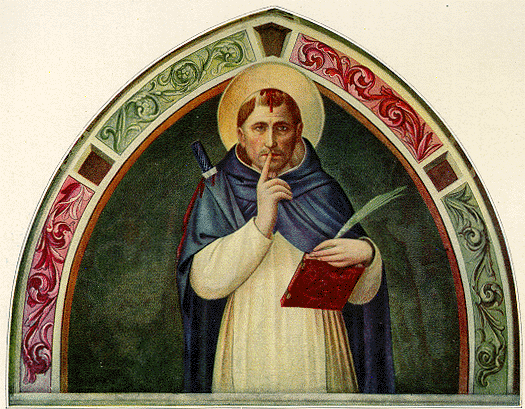
St Peter Martyr
 St Peter Martyr was a thirteenth-century Dominican inquisitor in northern Italy who through his life and martyrdom in 1252 achieved such renown and veneration among Christians that he was canonized less than one year after his death, the fastest canonisation in the history of the Church. Indeed so celebrated was St Peter that Dominican houses were mandated by the General Chapter of the Order to display his image alongside that of St Dominic in their churches and chapels.
St Peter Martyr was a thirteenth-century Dominican inquisitor in northern Italy who through his life and martyrdom in 1252 achieved such renown and veneration among Christians that he was canonized less than one year after his death, the fastest canonisation in the history of the Church. Indeed so celebrated was St Peter that Dominican houses were mandated by the General Chapter of the Order to display his image alongside that of St Dominic in their churches and chapels.However, in more recent times Peter’s life, or more particularly his occupation, has been found to be a source of controversy and his popularity has waned, which is perhaps understandable given the nature of his daily work.
So what to make of an inquisitor? St Peter’s role in the seeking out and prosecution of heretics can’t be ignored but any attempt to contend with this reality here would lead us away from considering Peter himself and into a more general discussion of the nature of the institution he was part of. Though, those who find the idea of an inquisitor-saint challenging might take comfort from knowing that Peter never had a single heretic handed over for execution, indeed he was renowned for his charity and leniency.
However, what made Peter a saint was not his inquisitorial activity, though no doubt his saintly virtues permeated his work, but rather his imitation of Jesus in willingly offering up his life for others. Medieval writers focus on what Karen Sullivan describes as Peter’s ‘Christlike passivity’ in the face of death. Two weeks before he was to die Peter preached in Milan ‘I know…that money for my death has already been deposited’ and on the day of his death he spoke with his brother, and fellow martyr, Domenico about the martyrs and sang with him hymns, most particularly the Victimae paschali laudes. Peter had accepted that he was being led like a lamb into a sharing in the death of the one Paschal Lamb.
And so he was. However, so united was Peter to Christ that from his spilled blood sprang immediate fruits. His murderer Carino of Balsamo repented of his crime and abandoned his heresy, fleeing to a Dominican Convent as a lay-brother. Peter’s giving himself up to death brought about the conversion and sanctification of Bl. Carino who has been venerated as a beatus since his own death.
In life Peter was a gentle, humble and holy man and in his death he echoed Christ’s plea ‘forgive them Father, for they know not what they do.’ Perhaps it comes as a surprise but this inquisitor was truly a martyr of mercy.
Sorry, the comment form is closed at this time.



A Website Visitor
Without saying that this comment above is not true, I have to add, that there was more. Perhaps even St. Peter martyr was not fully aware of it, but he was also a pion in a political game – and not a beautifull one. The pope was trying to extend the power of the State he possessed in the middle of Italy. Of course Milan wanted te be free and not occupied by the papal state. The pope used the inquisition as a tool to his purpose. St. Peter was the victim of that policy. It is not for nothing, that the money to pay his murderers was collected by bussiness men in Milan. The pope was so furious, that he proclaimed Saint Peter saint within a year. Again religious themes also as a cover up for political issues. Greetings and good wishes. Leo Raph. A. de Jong o.p. Member of the convent of Saint Peter martyr, in Rotterdam, the Netherlands.